
Joe's departure was immediately followed by the arrival of my parents and sister a few hours later. After two days exploring Thessaloniki, we boarded the sleeper train to Istanbul, which was due to leave at 8pm and arrive the next morning at 8am. Here is a picture of my sister on the train. I am on the top bunk, as you can probably tell from the sight of my shoe dangling in her face. Hayley is knitting with some yarn purchased at the Thessaloniki market, and she calls this pose "the granny shot."
Although the beds provided were quite comfortable, the word "sleeper" did turn out to be something of a misnomer for several reasons. First, going to Turkey requires a lot of business at the border. At one point, at approximately 3am, my father was woken by some official of one nation or the other, and instructed to follow. He did so, in his socks, and ended up having to walk across the train tracks to a train station that he described as "probably the same station where they filmed that scene in Fiddler on The Roof where the daughter leaves for Siberia." There he purchased our tourist visas, from a man he described as "the guy in charge of filling the entire room with cigarette smoke."
Second, there was a prostitute in a nearby room, and she was making a lot of noise. I only heard a few brief interludes of noise, but my parents had the misfortune of being right next to her. Apparently, prostitution is legal in Turkey, although I don't think she waited until we had crossed the border to start business. So alright, I guess the word "sleeper" could accurately describe my train experience, but my parents were not so lucky.
We arrived in Istanbul the next morning at about 10am. The conductor said we were late because there was "a lot of traffic." I don't know why traffic would prevent a train from being on time, but I guess it doesn't really matter all that much.
We walked from the train station to our hotel in Sultanahmet, a very pretty old neighborhood which is packed with hotels of all sorts, from youth hostels to the Four Seasons. Actually, as it turns out, the Four Seasons Istanbul happens to inhabit the former prison building where the movie Midnight Express took place. I haven't seen the film, but for the rest of the trip, my mind conjured up images from The Shawhank Redemption every time I passed the place.
It was a nice walk, right past the Hagia Sophia and the Blue Mosque. Unfortunately, we also passed about two hundred and ninety five carpet dealers, who saw us walking along with a suitcase in tow and immediately began their sales pitches. "You are from America?" they asked us. "Welcome to Paradise. You look so Turkish! Your daughter, she has a Turkish face! You need carpet? Come to my shop!" One man actually followed us for several blocks, offering to take us to his shop and to act as our tour guide. This deluge of salesmen was pretty much a constant presence for the next few days. They assaulted us in front of the Hagia Sophia, called to us from restaurants, begging us to come in, followed us to the Blue Mosque and waited for us as we exited, and tried to sell us postcards, hats, ceramics, meals, hotel rooms, and, of course, carpets. Every other person on the street was hawking carpets. I'm surprised the streets aren't carpeted in Istanbul.
Somehow we managed to push through the crowd of carpet salesmen to make our way to the Hagia Sophia, which is quite spectacularly beautiful. There was some reconstruction work going on inside, but it was still pretty stunning. The Hagia Sophia is a church now, although it was used as a mosque for a period of some time. It does however, inexplicably have giant decorative Arabic writing adorning the walls, and supposedly proclaiming the greatness of Allah, so it's not your typical church. I'm not exactly sure why this is the case (and even Lonely Planet didn't really clear it up for me). I would like to think that this was done in the spirit of inter-religious communication, tolerance, and general peace, love and happiness. Maybe that's the case. However, I'm also cynical enough to have my doubts about that hypothesis. Here's some pictures:

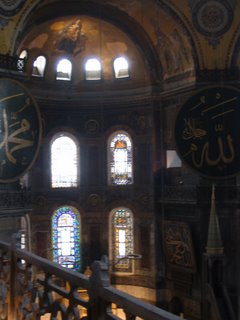
After the Hagia Sophia, we got accosted by a few more salesmen, ate lunch, got followed by a man who suggested that we come to his shop "because, you know, just by chance we might end up doing business!" and finally made our way into the Blue Mosque, which was also quite spectacular, though in a completely different way that Hagia Sophia. In fact, in some ways I think I found it even more impressive, probably in part because I haven't been in very many mosques before. Churches, I am familiar with; I've traveled a fair amount in Europe, and European travel almost always seems to involve at least several days of Going Inside Churches. Between my several months studying abroad in London, my family trip to Italy several years ago and my first four months in Greece, I have probably been inside more churches than all twelve apostles put together. I'm not complaining, mind you; in fact, I make a point of going inside Greek churches whenever possible, because I think they are generally quite beautiful. However, churches are not exactly new territory for me.
However, going inside a mosque was something new. None of the decorations show people or animals, because that is considered idolatry in Islam, so the entire inside of the huge dome was filled with beautiful elaborate abstract designs. The floor was carpeted, for prayer I assume (or maybe just because one of the carpet salesmen made a really good sales pitch to one Imam or another). I should have taken pictures, but I guess I was caught up in looking, so I didn't get around to it until that evening, when I took an exterior shot:

Those towers surrounding the dome are called minarets. The call to prayer comes five times daily, from various minarets of mosques around the city. The person who does the call to prayer is called a muezzin. I know all this because I took Major Western Religions at Grinnell, and I am sharing it with you just prove that sometimes a liberal arts education does come in handy. (It also proved very useful when I needed a name for my cat.)
As we left the Blue Mosque, we were met by the man who had suggested that we do business with him. That's right; he actually waited for us at the exit, and became slightly peevish when we refused to follow him to his carpet shop. However, no sooner had we left him behind than a new bunch of salesmen popped up. I discovered that a popular line is "Oh, you look so Turkish!" or "Hello, Turkish girl, come inside my shop!" Now, obviously these men did not really think we were Turkish, or they wouldn't have been speaking English. So I'm still wondering: would they have remarked on our uniquely "Turkish" appearance if we were blonde, blue-eyed Scandinavians?
After resting for a while at our hotel, we ventured out for dinner at 7:30 or so. This would be a laughably early mealtime in Greece, but Turks seem to eat earlier than Greeks. (Note: The Greeks eat late, and for the most part I have begun to do likewise. This was an easier adjustment for me than my move to college in Iowa, where they eat incredibly early. In fact, I suspect that Iowans and Greeks often eat dinner simultaneously, despite being eight time zones apart.) We went to a delicious restaurant called Hamdi, that has apparently been around for a long long time. It was quite good. Despite my usual avoidance of red meat, I even tried the meatballs and kebabs, which were delicious. Turkish food has some similarities to Greek food, but there are some marked differences as well: bread is big, puffy, and pita-like; pork is, of course, much less common; yogurt is less creamy and plainer, more like Indian raita than tzatziki; chick peas and hummus are far more common.
In fact, this would probably be a good time for me to comment on the many differences between Turkish and Greek restaurants. In Greece, even the simplest tavernas tend to b charming and atmospheric, with tablecloths and seats outside under tents or awnings. The kitchen is rarely visible to the customer, and the waiters are often relaxing and chatting over coffee and cigarettes, sometimes even when you wish they would come and take your order. You can walk into a Greek taverna and spend a number of minutes waiting for someone to come serve you. In Turkey on the other hand, you practically have to beat the waiters off with kebab sticks as you walk down the street, because they will persistently try to convince you to come into their restaurants. Once inside, (and you do usually sit inside, not outside like the Greeks) restaurants are often a bit more casual than tavernas, or at least a bit less old-fashioned in atmosphere. You can usually go up and look at the food before you order, which is nice. All in all, it was a welcome respite from Greek food, which I have been eating almost exclusively for the past four months.
Turkish and Greek coffee and desserts, it is worth noting, are almost completely the same. See my previous post for some details on that phenomenon. Basically, the Turks say the Greeks stole their stuff, and the Greeks say the Turks stole their stuff, and I really couldn't care less, as I come from a country where everyone steals everyone else's food all the time and what does it matter as long as it tastes good?
Day Two in Istanbul started a bit late, but we did make it to the Grand Bazaar by about noon. When I initially heard about the Grand Bazaar, I figured I might spend a few hours there, pick up a few souvenirs, and move on to other things. I like shopping, but I am not the sort of person who generally dedicates huge portions of time to buying things.
However, shopping in Istanbul is completely unlike any other shopping experience I have ever had. First of all, the Grand Bazaar is huge. It's this vast labyrinth of shops, bigger than some towns I've been in. They sell everything from jewelry and clothing to ceramics, spices, and chess sets. However, you can't just decide to buy something at the Grand Bazaar and hand over the money; you have to go through a whole complex process.

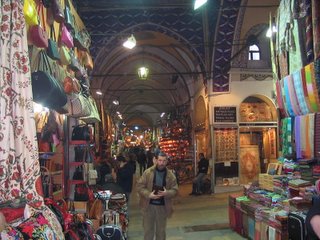
First of all, there are approximately several thousand shop owners crammed into one small area, and many of them are selling similar goods, so it's necessary to shop around in order to figure out who has the best prices. However, as far as I can tell, anyone who actually pays the price quoted to them by the shopkeeper is utterly naiive. They expect you to haggle with them. They even seem to want you to haggle with them. In some cases, they will haggle with you over prices whether you want them to or not.
For example, I wanted a Turkish tea cup or two. Turkish tea cups are these little glass cups with saucers and spoons that every other person on the street seems to be drinking from at any given time. They're rather distinctive looking and quite pretty, and you can buy whole sets of them in a variety of colors. I didn't want a whole set, though. I just wanted one. Or maybe two. I even found a merchant who was willing to sell them to me individually, but he wanted me to buy a whole set.
"I can't buy a whole set," I explained. "How will I ever take it home?"
"Look!" he said. "Two cups will cost ten lira. One set will only cost you thirty five lira. It is a much better deal."
"I know," I explained. I was completely in earnest. "But it's too big. I don't have room, I just want one or two cups..."
"Thirty!" he offered.
"I can't bring that whole box back to New York!" I exclaimed.
"Twenty-five!" he offered.
This went on and on until, big surprise, I ended up with an entire set of Turkish tea cups, spoons and saucers for what did seem to be a very good price, although there's really no way to be sure. If I put it in my suitcase the airline will probably charge me several hundred Euro for extra baggage. But the haggling was fun, anyway. Especially since Turkish shopkeepers tend to be very entertaining; I guess being personable is part of the job description. They call out to you every time you walk past their stall or stop even momentarily to glance at their goods; "Come inside!" they call, "How can I help you spend your money? Have a look at my garbage; it's cheaper than K-mart!" If you direct your attention to any specific object, they will immediately start extolling its virtues and explaining that they can give you "good price, very good price, just for you." When my father explained for approximately the two hundredth and seventieth time that he did not need a carpet, the salesman answered "Of course! Nobody need carpet!", but of course explained why he should buy one anyway.
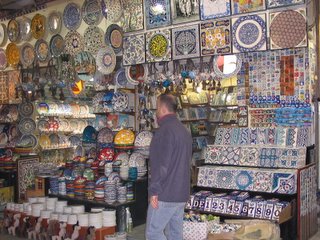

By the way, one Turkish lira is equal to approximately seventy five American cents, or sixty-some Euro cents. One Turkish lira used to be equal to approximately one-millionth of an American cent, but I guess they got sick of all of those zeroes and decided to change things.
By the end of the day at the Grand Bazaar, I had a new pashmina, a new dress, some shoes, tea, and some Turkish teacups, but thankfully no carpets. My entire family trudged back to our hotel to rest, and several hours later trudged out again for dinner at a restaurant known for its excellent Imam Bayaldi (that's eggplant stuffed with other vegetables).
Now, here's a question; what happens if you're a guy who's not really into monogamy, and you'd prefer to have a large number of women at your disposal rather than stick with just one? Well, if you go to Grinnell College, you get your name scrawled in ballpoint pen under the "List of Sketchy Guys" in the basement bathroom of the library. But if you are a member of the Turkish Sultan several centuries back, you get a really gorgeous house, a large number of wives and concubines that your mother looks after, and a bunch of Eunuch servants to boot.
This is Topkapi Palace, or more specifically, the Harem of Topkapi Palace. It costs extra to go inside, you have to take a guided tour, and it's not exactly a monument to progressive thinking in regards to gender. However, it is quite spectacular. I'd say that I want to move right in, but that makes my inner feminist cringe and squirm and yell things. So I'm not moving in. But I took a hell of a lot of pictures.

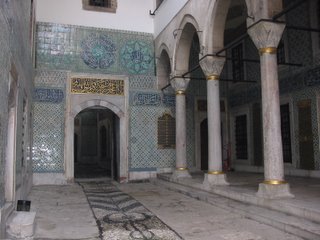
Above is an entry hall and a courtyard where the concubines were presented to the sultan. Below, there's me next to a big fireplace, and some beautiful tiles from some region of Turkey known for its tiles. It might be called Iznik. But I'm not sure.
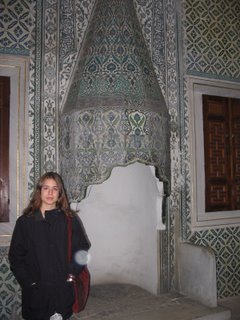

After the Palace we decided that we were sick of Europe, so we went to Asia for lunch. No kidding. You can do that in Istanbul. All you have to do is get on the ferry, which costs a mere one lira, and within fifteen minutes, you are in Asia. We went to a region known as Uskudar, which is not frequently visited by tourists. It's rather traditional, with a fairly large portion of women wearing headscarves. It was quite a nice change from the tourist-filled streets of Sultanahmet. I was amused by the large number of schoolkids hanging around gossiping over what looked like new report cards. I also spent some time drooling over the delicious fruits and vegetables at the market, and the pistachios. I don't know what's up with those Turkish pistachios, but they are way better than American pistachios ever dreamed of being.
Here is a picture of our Asian lunch. Well, at least, these were the offerings available to us. We did not actually eat all of things in this picture, though we may have been able to if we had really put our minds to it.

After lunch and some wandering through Uskudar, we headed back to Europe, took a brief detour through the spice market...

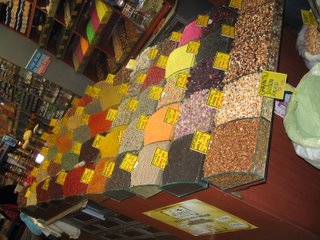
...and purchased some Turkish Delight from the store that supposedly invented the stuff. I know that I have been somewhat ambivalent about Turkish Delight in the past, but I am keeping an open mind and perhaps I will be delighted after all when I actually get around to opening my box of assorted delights. The pistachio samples they had were really quite excellent, I must say.
And then, sadly, we left Istanbul on the 8pm train. The evening trip was actually quite peaceful this time; there did not appear to be any illicit activity taking place in close proximity to us, and the Greek government let me back in the country without any hassling, which was very nice of them. Well, they did come inside our room and look around, supposedly for customs purposes, but it did not take very long. It was rather brief, actually; I probably could have had several pounds of illegal substances stashed in various corners of the room, and I doubt that anyone would have noticed. However, I didn't, so all is well, although it did take us longer to get back to Thessaloniki than it took my parents to get there from New York. Maybe there was traffic. I really don't know.
And thus I conclude my Turkish Adventure. Perhaps soon I will update again with Vacation Episode III: Olympus, Dion, and the Prespa Lakes.


4 comments:
I was going to say that, too. In both Athens and Thessaloniki, maitre d's can be a bit pushy.
Also, I think Thessaloniki's food is more influenced by Turkish cuisine than other areas of Greece (but I'm mostly sourcing Frommers).
And sleeper cars are better than the alternative.
Emily: Excellent account. I have also been to Istanbul and the hawkers were trying to sell me leather goods.
With regard to Hagia Sofia: As far as I know, Hagia Sofia is still a museum and it has not been reverted to Christian Church. Hence the large disks with the Arab letters from the Kuran, which were left behind from its more recent use as a mosque. But at least after ceasing being a mosque and converted to a museum, arheologists have peeled away the wall paint added by the Ottomans and revealed the exquisite Christian mosaics from the Byzantine period. Maybe that's what misled you into thinking that it is now a Church once again.
Emily....I enjoy your accounts of life in Thessalonika. As a past resident of Athens, I enjoy other American's take on the country. You bring me back and it's a trip I love to take. Thanks...Keep posting
All about Turkish Carpets and kilim
www.memorycarpets.com
Post a Comment